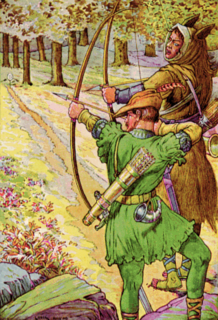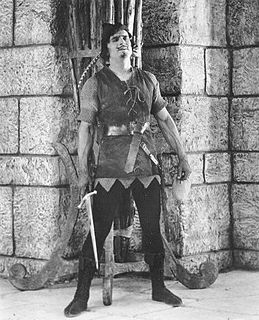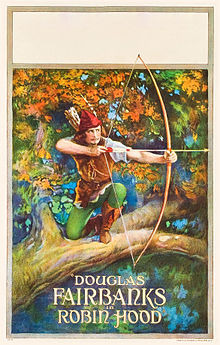
Ivanhoe: A Romance by Walter Scott is a historical novel published in three volumes, in 1819, as one of the Waverley novels. At the time it was written, the novel represented a shift by Scott away from writing novels set in Scotland in the fairly recent past to England in the Middle Ages. Ivanhoe proved to be one of the best-known and most influential of Scott's novels.

Robin Hood is a legendary heroic outlaw originally depicted in English folklore and subsequently featured in literature and film. According to legend, he was a highly skilled archer and swordsman. In some versions of the legend, he is depicted as being of noble birth, and in modern retellings he is sometimes depicted as having fought in the Crusades before returning to England to find his lands taken by the Sheriff. In the oldest known versions he is instead a member of the yeoman class. Traditionally depicted dressed in Lincoln green, he is said to have robbed from the rich and given to the poor.

English mythology is the collection of myths that have emerged throughout the history of England, sometimes being elaborated upon by successive generations, and at other times being rejected and replaced by other explanatory narratives. These narratives consist of folk traditions developed in England after the Norman Conquest, integrated with traditions from Anglo-Saxon mythology, Christian mythology, and Celtic mythology. Elements of the Matter of Britain, Welsh mythology and Cornish mythology which relate directly to England are included, such as the foundation myth of Brutus of Troy and the Arthurian legends, but these are combined with narratives from the Matter of England and traditions from English folklore.
Viking metal is a style of heavy metal music characterized by a lyrical and thematic focus on Norse mythology, Norse paganism, and the Viking Age. Viking metal is quite diverse as a musical style, to the point where some consider it more a cross-genre term than a genre, but it is typically seen as black metal with influences from Nordic folk music. Common traits include a slow-paced and heavy riffing style, anthemic choruses, use of both sung and harsh vocals, a reliance on folk instrumentation, and often the use of keyboards for atmospheric effect.

Historical reenactment is an educational or entertainment activity in which mainly amateur hobbyists and history enthusiasts put on uniforms and follow a plan to recreate aspects of a historical event or period. This may be as narrow as a specific moment from a battle, such as the reenactment of Pickett's Charge presented during the Great Reunion of 1913, or as broad as an entire period, such as Regency reenactment.

Sir Guy of Gisbourne is a character from the Robin Hood legends of English folklore. He first appears in "Robin Hood and Guy of Gisborne", where he is a hired killer who attempts to kill Robin Hood but is killed by him. In later depictions, he has become a romantic rival to Robin Hood for Maid Marian's love.

Medieval films imagine and portray the Middle Ages through the visual, audio and thematic forms of cinema.

Medieval reenactment is a form of historical reenactment that focuses on re-enacting European history in the period from the fall of Rome to about the end of the 15th century. The second half of this period is often called the Middle Ages. This multiplicity of terms is compounded by the variety of other terms used for the period.

Medievalism is a system of belief and practice inspired by the Middle Ages of Europe, or by devotion to elements of that period, which have been expressed in areas such as architecture, literature, music, art, philosophy, scholarship, and various vehicles of popular culture. Since the 17th century, a variety of movements have used the medieval period as a model or inspiration for creative activity, including Romanticism, the Gothic revival, the pre-Raphaelite and arts and crafts movements, and neo-medievalism.
Dark Ages reenactment is generally considered a sub-branch of Medieval reenactment focussing on the 1st millennium AD beginning with the fall of the Western Roman Empire and ending with the High Middle Ages.

Rabbit Hood is a 1949 Merrie Melodies cartoon released on December 24, 1949. The entry was directed by Chuck Jones and written by Michael Maltese, and features Bugs Bunny.
The following outline is provided as an overview of and topical guide to the Middle Ages:
Stephen Thomas Knight MA (Oxon.), PhD (Sydney), F.A.H.A., F.E.A. was, until September 2011, a distinguished research professor in English literature at Cardiff University; and is a professorial fellow of Literature at the University of Melbourne. His areas of expertise include medieval English and European literature, Robin Hood, Merlin, cultural studies, crime fiction, and Australian matters. He has authored over thirty books, and is well known in the public sphere for his contribution to a range of fields. His most recent books have been The Politics of Myth (2015), Towards Sherlock Holmes: A Thematic History of Crime Fiction in the 19th Century World (2017), Australian Crime Fiction: A 200-year History (2018), The Fiction of G.W.M. Reynolds: The Man Who Outsold Dickens (2019) and The University is Closed for Open Day: Themes and Scenes from 21st Century Australia (2019).

This article is about depictions of the Teutonic Knights in popular culture.
Richard I of England has been depicted many times in romantic fiction and popular culture.

John of England has been portrayed many times in fiction, generally reflecting the overwhelmingly negative view of his reputation.
Edward I of England has been portrayed in popular culture a number of times.

Friar Tuck is one of the legendary Merry Men, the band of heroic outlaws in the folklore of Robin Hood.

Lady of the Forest: A Novel of Sherwood is a 1992 historical fiction novel by American author Jennifer Roberson. A re-telling of the Robin Hood legend from the perspective of twelve characters associated with the legend, the story centers around English noblewoman Lady Marian FitzWalter's encounters with Lord Robert of Locksley and his scheming rival the Sheriff of Nottingham amid the backdrop of Prince John's schemes – he aims to increase his own wealth and power at the expense of post-Conquest England and his brother, King Richard.














